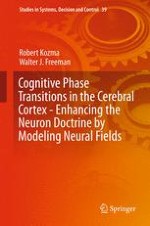Freeman Neurodynamics may be complementary to conventional analysis of direct cortical recording. (ECoG) Freeman and Kozma have discovered nonlinear dynamical phenomena in cortex, involving the dendritic feltwork of Layer I. After Hilbert analysis, a strip of electrodes with sufficient spatial density reveals intermittent phase equilibria interrupted by
\(\sim \)10 Hz phase collapses. This activity propagates via phase dispersion. Kozma and Freeman, Advances in cognitive neurodynamics, 2015, [
10] propose that “the rapid propagation
of phase dispersion over the hemisphere is the manifestation of the cognitive broadcast as described in Baars’ global workspace theory.” Sensory contents might be expressed in “spatial patterns of amplitude modulation
of beta and gamma waves.” This view emerges from Freeman K sets, including recent modeling using the concept of neuropercolation in sets of cellular automata. It also implies scale-free dynamics and inverse power-law distributions of cortical connectivity and EEG power. Yet what is it that is being propagated? In the conventional view, conscious visual percepts emerge from more than 40 visuotopical activity arrays linked bidirectionally, so that
adaptive resonance enables
a problem-solving trajectory terminating in a coherent visual gestalt via winner-take-all
competition
. New findings indicate that such visual gestalts emerge in at high levels of the visual hierarchy, whence they are accurately propagated to the prefrontal lobe
, consistent with global workspace theory Panagiotaropoulos et al., Neuron 74(5):924–935, 2012, [
12] and Baars et al., Front
Psychol 4:200, 2013, [
2]. Conventional ECoG analysis may reflect the
cognitive aspect of global binding and broadcasting, while Freeman
Neurodynamics may convey intentional information—biological goals and conditioned stimuli. In Franklin’s terms, the dendritic neuropil
may shape action selection
, while axonal resonance may support perceptual contents. One possibility
is that cortex evolved a variety of Sparse Distributed Memory (SDM) Kanerva, Sparse distributed memory, 2003, [
7] and Snaider and Franklin, Cogn. Comput. 6(3):510–527, 2014, [
13], a very efficient, non-local way to pack information into high-dimensional bit vectors. This suggests that some brain region acts as a minimal retrieval vector for episodic learning. The hippocampus
and the claustrum
may be candidates for such an SDM vector substrate
.
